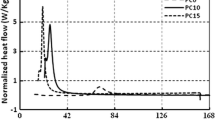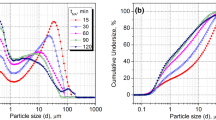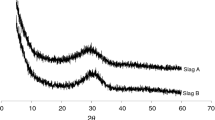Abstract
In this work, the effect of Portland cement (PC) on 1 % Na2O equivalent of sodium sulphate-activated ground granulated blast-furnace slag (hereafter referred as slag) in terms of compressive strength and pH value before and after exposure to different elevated temperatures has been investigated. Slag was partially replaced with PC at levels of 0, 5, 10 and 15 %, by mass. The specimens were exposed to different elevated temperatures ranging from 200 to 800 °C with an interval of 200 °C. The various phases formed due to elevated temperature decomposition were identified using X-ray diffraction, thermogravimetric analysis and scanning electron microscopy. The results indicated that the inclusion of 10 and 15 % PC enhanced the compressive strength and raised the pH value. On the other hand, the neat activated slag showed the highest fire resistance. The pH value decreased with increasing elevated temperatures.














Similar content being viewed by others
References
Fernández-Jiménez A, Palomo JG, Puertas F. Alkali-activated slag mortars: mechanical strength behavior. Cem Concr Res. 1999;29:1313–21.
Rashad AM, Bai Y, Basheer PAM, Milestone NB, Collier NC. Hydration and properties of sodium sulfate activated slag. Cem Concr Compos. 2013;37:20–9.
Wu X, Jiang W, Roy DM. Early activation and properties of slag cement. Cem Concr Res. 1990;20:961–74.
Rashad AM, Bai Y, Basheer PAM, Collier NC, Milestone NB. Chemical mechanical stability of sodium sulfate activated slag after exposure to elevated temperature. Cem Concr Res. 2012;42:333–43.
Wang S-D, Scrivener KL, Pratt PL. Factors affecting the strength of alkali-activated slag. Cem Concr Res. 1994;24(6):1033–43.
Puertas F. Alkali-activated slag cements: present and future. Mater Constr. 1995;45(239):53–64.
Pu XC, Gan CC, Wang SD, Yang CH. Research reports of an alkali-activated slag cement and concrete, vol. 6. Chongqing: Chongqing Institute of Architecture and Engineering; 1988 (in Chinese).
Rashad AM, Khalil MH. A preliminary study of alkali-activated slag blended with silica fume under the effect of thermal loads and thermal shock cycles. Constr Build Mater. 2013;40:522–32.
Rovnaník P, Bayer P, Rovnaníková P. Characterization of alkali activated slag paste after exposure to high temperatures. Constr Build Mater. 2013;47:1479–87.
Karahan O, Yakupoğlu A. Resistance of alkali-activated slag mortar to abrasion and fire. Adv Cem Res. 2011;23(6):289–97.
Guerrieri M, Sanjayan J, Collins F. Residual strength properties of sodium silicate alkali activated slag paste exposed to elevated temperatures. Mater Struct. 2010;43:765–73.
Guerrieri M, Sanjayan JG. Behavior of combined fly ash/slag-based geopolymers when exposed to high temperatures. Fire Mater. 2009;. doi:10.1002/fam.1014.
Bernal SA, Rodrίguez ED, de Gutiérrez RM, Gordillo M, Provis JL. Mechanical and thermal characterisation of geopolymers based on silicate-activated metakaolin/slag blends. J Mater Sci. 2011;. doi:10.1007/s10853-011-5490-z.
Morsy MS, Rashad AM, El-Nouhy HA. Effect of elevated temperature on physic-mechanical properties of metakaolin blended cement mortar. Struct Eng Mech. 2009;31(1):1–10.
Seleem HEl_D, Rashad AM, Elsokary T. Effect of elevated temperature on physic-mechanical properties of blended cement concrete. Constr Build Mater. 2011;25:1009–17.
Rashad AM, Zeedan SR. The effect of activator concentration on the residual strength of alkali-activated fly ash pastes subjected to thermal load. Constr Build Mater. 2011;25:3098–107.
Phan LT. Fire performance of high strength concrete: a report of the state-of-the-art. Gaithersburg: Building and Fire Research Laboratory, National Institute of Standards and Technology; 1996.
Rashad AM. An exploratory study on sodium sulfate activated slag modified with Portland cement. Mater Struct. 2014;. doi:10.1617/s11527-014-0468-3.
Zuda L, Pavlík Z, Rovnaníková P, Bayer P, Černý R. Properties of alkali activated aluminosilicate material after thermal load. Int J Thermophys. 2006;27(4):1250–63.
Zuda L, Rovnaník P, Bayer P, Černý R. Effect of high temperatures on the properties of alkali activated aluminosilicate with electrical porcelain. Int J Thermophys. 2008;29:693–705.
Zuda L, Bayer P, Rovnaník P, Černý R. Mechanical and hydric properties of alkali-activated aluminosilicate composite with electrical porcelain aggregates. Cem Concr Compos. 2008;30:266–73.
Zuda L, Drchalová J, Rovnaník P, Bayer P, Keršner Z, Černý R. Alkali-activated aluminosilicate composite with heat-resistant lightweight aggregates exposed to high temperatures: mechanical and water transport properties. Cem Concr Compos. 2010;32:157–63.
Guerrieri M, Sanjayan J, Collins F. Residual compressive behavior of alkali-activated concrete exposed to elevated temperatures. Fire Mater. 2008;. doi:10.1002/fam.983.
Yongde L, Yao S. Preliminary study on combined-alkali–slag paste materials. Cem Concr Res. 2000;30:963–6.
Bonk F, Schneider J, Cincotto MA, Panepucci H. Characterization by multinuclear high-resolution NMR of hydration products in activated blast-furnace slag pastes. J Am Ceram Soc. 2003;86(10):1712–9.
Atiş CD, Bilim C, Çelik Ö, Karahan O. Influence of activator on the strength and drying shrinkage of alkali-activated slag mortar. Constr Build Mater. 2009;23:548–55.
Haha MB, Saout GL, Winnefeld F, Lothenbach B. Influence of activator type on hydration kinetics, hydrate assemblage and microstructural development of alkali activated blast-furnace slags. Cem Concr Res. 2011;41:301–10.
Shi C, Krivenko PV, Roy D. Alkali-activated cements concretes. 1st ed. Boca Raton: Taylor and Francis; 2006.
Fernández-Jiménez A, Puertas F. Structure of calcium silicate hydrates formed in alkaline-activated slag: influence of type of alkaline activator. J Am Ceram Soc. 2003;86(8):1389–94.
Cheng TW, Chiu JP. Fire-resistant geopolymer produced by granulated blast furnace slag. Miner Eng. 2003;16:205–10.
Aydin S, Baradan B. High temperature resistance of alkali-activated slag- and Portland cement-based reactive powder concrete. ACI Mater J. 2012;109-M44:463–70.
Chi M. Effects of dosage of alkali-activated solution and curing conditions on the properties and durability of alkali-activated slag concrete. Constr Build Mater. 2012;35:240–5.
Zuda L, Rovnamík P, Bayer P, Černý R. Thermal properties of alkali-activated aluminosilicate composite with lightweight aggregates at elevated temperatures. Fire Mater. 2011;35:231–44.
Collepardi M. The new concrete. 1st ed. Castrette di Villorba TV: Grafiche Tinoretto; 2006.
Bazant ZP, Kaplan MF. Concrete at high temperatures—materials properties and mathematical models. Harlow: Longman Group Limited; 1996. 412 pp.
Villain G, Thiery M, Platret G. Measurement methods of carbonation profile in concrete: thermogravimetry, chemical analysis and gammadensimetry. Cem Concr Res. 2007;37:1182–92.
Reis PNB, Ferreira JAM, Antunes FV, Costa JDM. Flexural behavior of hybrid laminated composites with natural fibers: coupling agent effect. J Degrad Stab. 2008;93:1170–5.
Taylor HFW. Cement chemistry. London: Thomas Telford; 1997.
Greene KT. Early hydrations of Portland cement. In: Proceedings of the fourth international symposium on the chemistry of cements, Washington, DC, 1960 p. 359–58.
Song S, Sohn D, Jennings HM, Mason TO. Hydration of alkali-activated ground granulated blast furnace slag. J Mater Sci. 2000;35:249–57.
Gebhart RF. Survey of North American Portland cement. Cem Aggreg. 1995;17:175–89.
Song S, Jennings HM. Pore solution chemistry of alkali-activated ground granulated blast-furnace slag. Cem Concr Res. 1999;29:159–70.
Fernández-Jimènez A, Puertas F. Effect of activator mix on the hydration and strength behavior of alkali-activated slag cement. Adv Cem Res. 2003;15(3):129–36.
Böhni H. Corrosion in reinforced concrete structures. Boca Raton: CRC Press; 2005.
Acknowledgements
The author was sponsored by Egyptian government for his academic visit to Queen’s University Belfast (QUB), UK. The slag used in this research was supplied by Hanson Cement. Prof. P. A. M. Basheer, Dr. Yun Bai and the facilities provided by the School of Planning, Architecture and Civil Engineering at Queen’s University Belfast are also gratefully acknowledged.
Author information
Authors and Affiliations
Corresponding author
Rights and permissions
About this article
Cite this article
Rashad, A.M. An exploratory study on sodium sulphate-activated slag blended with Portland cement under the effect of thermal loads. J Therm Anal Calorim 119, 1535–1545 (2015). https://doi.org/10.1007/s10973-014-4345-7
Received:
Accepted:
Published:
Issue Date:
DOI: https://doi.org/10.1007/s10973-014-4345-7




